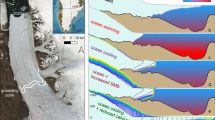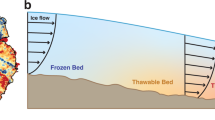Abstract
The floating ice shelves along the seaboard of the Antarctic ice sheet restrain the outflow of upstream grounded ice1,2. Removal of these ice shelves, as shown by past ice-shelf recession and break-up, accelerates the outflow3,4, which adds to sea-level rise. A key question in predicting future outflow is to quantify the extent of calving that might precondition other dynamic consequences and lead to loss of ice-shelf restraint. Here we delineate frontal areas that we label as ‘passive shelf ice’ and that can be removed without major dynamic implications, with contrasting results across the continent. The ice shelves in the Amundsen and Bellingshausen seas have limited or almost no ‘passive’ portion, which implies that further retreat of current ice-shelf fronts will yield important dynamic consequences. This region is particularly vulnerable as ice shelves have been thinning at high rates for two decades5 and as upstream grounded ice rests on a backward sloping bed, a precondition to marine ice-sheet instability6,7. In contrast to these ice shelves, Larsen C Ice Shelf, in the Weddell Sea, exhibits a large ‘passive’ frontal area, suggesting that the imminent calving of a vast tabular iceberg8 will be unlikely to instantly produce much dynamic change.
This is a preview of subscription content, access via your institution
Access options
Subscribe to this journal
Receive 12 print issues and online access
$209.00 per year
only $17.42 per issue
Buy this article
- Purchase on Springer Link
- Instant access to full article PDF
Prices may be subject to local taxes which are calculated during checkout


Similar content being viewed by others
References
Dupont, T. K. & Alley, R. B. Assessment of the importance of ice-shelf buttressing to ice-sheet flow. Geophys. Res. Lett. 32, L04503 (2005).
Gagliardini, O., Durand, G., Zwinger, T., Hindmarsh, R. C. A. & Le Meur, E. Coupling of ice-shelf melting and buttressing is a key process in ice-sheet dynamics. Geophys. Res. Lett. 37, L14501 (2010).
Rignot, E. et al. Accelerated ice discharge from the Antarctic Peninsula following the collapse of Larsen B Ice Shelf. Geophys. Res. Lett. 31, L18401 (2004).
Berthier, E., Scambos, T. A. & Shuman, C. A. Mass loss of Larsen B tributary glaciers (Antarctic Peninsula) unabated since 2002. Geophys. Res. Lett. 39, L13501 (2012).
Paolo, F. S., Fricker, H. A. & Padman, L. Volume loss from Antarctic ice shelves is accelerating. Science 348, 327–331 (2015).
Weertman, J. Stability of the junction of an ice sheet and an ice shelf. J. Glaciol. 13, 3–11 (1974).
Schoof, C. Ice sheet grounding line dynamics: steady states, stability, and hysteresis. J. Geophys. Res. 112, F03S28 (2007).
Jansen, D. et al. Brief communication: newly developing rift in Larsen C Ice Shelf presents significant risk to stability. Cryosphere 9, 1223–1227 (2015).
Pritchard, H. D. et al. Antarctic ice-sheet loss driven by basal melting of ice shelves. Nature 484, 502–505 (2012).
O’Donnell, R., Lewis, N., McIntyre, S. & Condon, J. Improved methods for PCA-based reconstructions: case study using the Steig et al. (2009) Antarctic temperature reconstruction. J. Clim. 24, 2099–2115 (2011).
Skvarca, P. Changes and surface features of the Larsen Ice Shelf, Antarctica, derived from Landsat and Kosmos mosaics. Ann. Glaciol. 20, 6–12 (1994).
Rott, H., Skvarca, P. & Nagler, T. Rapid collapse of northern Larsen Ice Shelf, Antarctica. Science 271, 788–792 (1996).
Vaughan, D. G. & Doake, C. S. M. Recent atmospheric warming and retreat of ice shelves on the Antarctic Peninsula. Nature 379, 328–331 (1996).
Scambos, T. A., Hulbe, C. A. & Fahnestock, M. Antarctic Peninsula Climate Variability: Historical and Paleoenvironmental Perspectives (American Geophysical Union, 2013).
De Angelis, H. & Skvarca, P. Glacier surge after ice shelf collapse. Science 299, 1560–1562 (2003).
Seehaus, T., Marinsek, S., Helm, V., Skvarca, P. & Braun, M. Changes in ice dynamics, elevation and mass discharge of Dinsmoor–Bombardier–Edgeworth glacier system, Antarctic Peninsula. Earth Planet. Sci. Lett. 427, 125–135 (2015).
Gudmundsson, G. H. Ice-shelf buttressing and the stability of marine ice sheets. Cryosphere 7, 647–655 (2013).
Morlighem, M. et al. Spatial patterns of basal drag inferred using control methods from a full-Stokes and simpler models for Pine Island Glacier, West Antarctica. Geophys. Res. Lett. 37, L14502 (2010).
Gillet-Chaulet, F. et al. Greenland ice sheet contribution to sea-level rise from a new-generation ice-sheet model. Cryosphere 6, 1561–1576 (2012).
Fürst, J. J. et al. Assimilation of Antarctic velocity observations provides evidence for uncharted pinning points. Cryosphere 9, 1427–1443 (2015).
Morland, L. W. Dynamics of the West Antarctic Ice Sheet (Kluwer Acad., 1986).
Doake, C. S. M., Corr, H. F. J., Rott, H., Skvarca, P. & Young, N. W. Breakup and conditions for stability of the northern Larsen Ice Shelf, Antarctica. Nature 391, 778–780 (1998).
Massom, R. A. et al. External influences on the Mertz Glacier Tongue (East Antarctica) in the decade leading up to its calving in 2010. J. Geophys. Res. 120, 490–506 (2015).
Braun, M., Humbert, A. & Moll, A. Changes of Wilkins Ice Shelf over the past 15 years and inferences on its stability. Cryosphere 3, 41–56 (2009).
Depoorter, M. A. et al. Calving fluxes and basal melt rates of Antarctic ice shelves. Nature 502, 89–92 (2013).
Rignot, E., Jacobs, S., Mouginot, J. & Scheuchl, B. Ice-shelf melting around Antarctica. Science 341, 266–270 (2013).
Dutrieux, P. et al. Pine Island Glacier ice shelf melt distributed at kilometre scales. Cryosphere 7, 1543–1555 (2013).
Kuipers Munneke, P., Lightenberg, S. R. M., van den Broeke, M. R. & Vaughan, D. G. Firn air depletion as a precursor of Antarctic ice-shelf collapse. J. Glaciol. 60, 205–214 (2014).
Hellmer, H. H., Kauker, F., Timmermann, R., Determann, J. & Rae, J. Twenty-first-century warming of a large Antarctic ice-shelf cavity by a redirected coastal current. Nature 485, 225–228 (2012).
Bindschadler, R. Climate change—hitting the ice sheets where it hurts. Science 311, 1720–1721 (2006).
Scambos, T., Haran, T., Fahnestock, M., Painter, T. & Bohlander, J. MODIS-based mosaic of Antarctica (MOA) data sets: continent-wide surface morphology and snow grain size. Remote Sens. Environ. 111, 242–257 (2007).
Acknowledgements
This study received primary funding from the French National Research Agency (ANR) under the SUMER (Blanc SIMI 6) 2012 project referenced as ANR-12-BS06-0018. Results presented in this publication are based on numerical simulations conducted either at CIMENT (Calcul Intensif Modélisation Expérimentation Numérique et Technologique), the high-performance computing centre of the Grenoble University, which is supported on local, county and regional levels via the CIRA project (Calcul intensif en Rhône Alpes), or at the CINES (Centre Informatique National de l’Enseignement Supérieur) computing centre under allocation 2015-016066 from GENCI (Grand Equipement National de Calcul Intensif). Results presented here also received support and benefited from the Elmer/Ice development team at the CSC-IT Center for Science Ltd (Finland). The velocity analysis on Wilkins was funded by the German Research Foundation (DFG) within the priority programme 1158 Antarctic Research under contract number BR2105/8-1 and as co-fund action to the HGF Alliance Remote Sensing and Earth System Dynamics. During the revision phase of the manuscript, the first author received funding from the DFG-project FU1032/1-1.
Author information
Authors and Affiliations
Contributions
G.D. initiated the quantification of ice-shelf buttressing and J.J.F. elaborated on it with a focus on identifying passive shelf ice. J.J.F. led the writing of the manuscript, in which he received support from all authors. The data assimilation was realized by J.J.F. and the Antarctic-wide calving experiments were designed and conducted by J.J.F. The research was directed in constant discussion with G.D., F.G.-C. and O.G. Software maintenance and technical support from L.T. was essential to render the conducted experiments possible. Velocities of Wilkins Ice Shelf were inferred and provided by M.R. and M.B.
Corresponding author
Ethics declarations
Competing interests
The authors declare no competing financial interests.
Supplementary information
Supplementary Information
Supplementary Information (PDF 1918 kb)
Rights and permissions
About this article
Cite this article
Fürst, J., Durand, G., Gillet-Chaulet, F. et al. The safety band of Antarctic ice shelves. Nature Clim Change 6, 479–482 (2016). https://doi.org/10.1038/nclimate2912
Received:
Accepted:
Published:
Issue Date:
DOI: https://doi.org/10.1038/nclimate2912
This article is cited by
-
Sustained ocean cooling insufficient to reverse sea level rise from Antarctica
Communications Earth & Environment (2024)
-
Ice shelves guarded by snow shields
Nature Climate Change (2023)
-
Satellite record reveals 1960s acceleration of Totten Ice Shelf in East Antarctica
Nature Communications (2023)
-
Variable temperature thresholds of melt pond formation on Antarctic ice shelves
Nature Climate Change (2023)
-
IceLines – A new data set of Antarctic ice shelf front positions
Scientific Data (2023)



